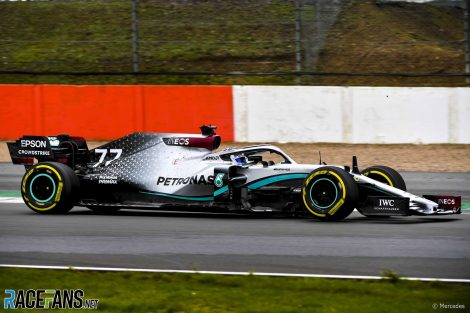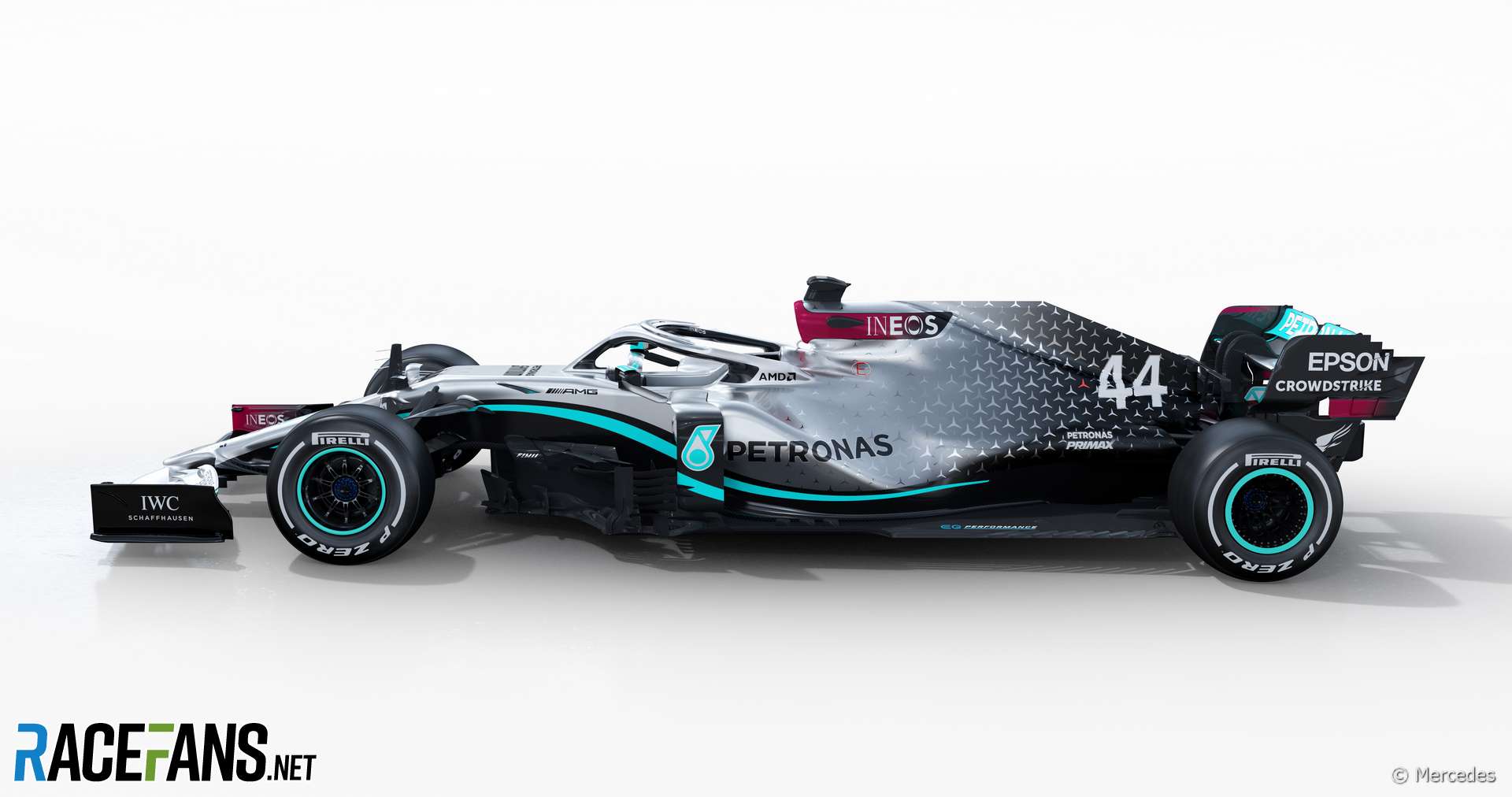Mercedes says it has applied development techniques from its Formula E programme in creating its new power unit for the 2020 F1 season.
The managing director of Mercedes-AMG High Performance Powertrains Andy Cowell said the new M11 EQ Performance power unit had benefitted from the team’s involvement in Formula E.“Some of the development learning there has now fed back into Formula 1,” Cowell confirmed. “So from Melbourne this year, our Formula 1 hybrid system will benefit from our Formula E development work.
“We’ve also made some manufacturing improvements that originate in the FE programme. We manufacture our own electric machines and some of the techniques developed for Formula E are being applied to the Formula One electric machines this year as well.
“This is exciting to see; in the past, we’ve seen gains from the Project One [road car] development feed back into F1, now we are also seeing Formula E engineering and manufacturing technology feeding back into F1.”

“At the beginning of last year, the cooling capacity of our car was insufficient, which resulted in some challenging races,” he said. “At the opening two races, when it became clear we didn’t have enough cooling capacity, we started working on proving out the Power Unit at higher temperature limits.
“By Austria we had managed to prove out an extra four degrees on the water temperature which helped make the Spielberg race slightly more bearable, but it was still a very painful weekend for the team. Since then, we have continued that trajectory, so we’re trying to contain the total heat rejection that needs to be cooled by the chassis cooling systems.”
Although the calendar has expanded to 22 races for 2020 – providing the postponed Chinese Grand Prix eventually goes ahead – at least one of the team’s power units will have to cover eight races, adding to the demand on its design.
[smr2020test]”For this year we are putting significant effort into making sure that all the cooling fluids on the power unit operate at a higher temperature,” said Cowell. “This increases the temperature difference between that coolant fluid and the ambient temperature that we are racing in, which increases the effectiveness of the cooling system.
“That’s a tough challenge though, because large parts of the engine are made from aluminium and the temperatures that we are operating at mean the material properties are decaying quite rapidly. Managing that over an eight-race distance power unit cycle is a tough engineering challenge but that’s what we are striving for.
“As power unit engineers we don’t just focus on crankshaft power, we also focus a tremendous amount on the packaging and reducing the overheads for the aerodynamicist, so that they can mainly focus on keeping the car planted through the corner.”
Advert | Become a RaceFans supporter and
2020 F1 season
- Pictures: Wrecked chassis from Grosjean’s Bahrain fireball crash to go on display
- Bottas vs Rosberg: Hamilton’s Mercedes team mates compared after 78 races each
- F1 revenues fell by $877 million in Covid-struck 2020 season
- Hamilton and Mercedes finally announce new deal for 2021 season
- F1 audience figures “strong” in 2020 despite dip in television viewers





ruliemaulana (@ruliemaulana)
14th February 2020, 11:57
LoL. So much for 2021 costs cap.
Gabriel (@rethla)
14th February 2020, 12:24
There are no costcaps.
bosyber (@bosyber)
14th February 2020, 12:25
Well, there never was a cost cap on the engine development anyway @ruliemaulana, though there is a maximum price they can be sold for, for reasons much like this, I think.
Alianora La Canta (@alianora-la-canta)
17th February 2020, 19:37
@bosyber Which still means the teams running that engine have an improper advantage if the manufacturer team is happy to absorb the losses – something they will be especially happy to do if needing to divert funds from other parts of the operation.
bosyber (@bosyber)
17th February 2020, 23:13
@alianora-la-canta indeed so, but that unadressed possible imbalance in how much a PU manufacturer is willing/able to invest in developing their F1 PU remains unchanged whether Mercedes (and/or Renault) take(s) advantage of the synergy between Formula-E and F1 PU development or not.
vjanik (@vjanik)
14th February 2020, 12:09
“At the beginning of last year, the cooling capacity of our car was insufficient, which resulted in some challenging races,”
hehe. you mean winning the first 9 races of the season with a 1-2 finish in the first 5? breaking all the records for the best start to a season ever?
insufficient for what?
Gabriel (@rethla)
14th February 2020, 12:27
It doesnt matter if you are the best in the field you still have something limiting the performance to work on. The engine team dont go on vacation just because they are dominant, they wouldnt be dominant if they did…
bosyber (@bosyber)
14th February 2020, 12:27
@vjanik I read that as like otherwise they wouldn’t have been at the mercy of Ferrari mistakes (dependable though they proved) at all to be in the winning car, so insufficient to be able to rest on their laurels (which they don’t want to do anyway, but still). So, unless the competition made good jumps, that’s where they are now.
anon
14th February 2020, 18:30
@vjanik, first nine races? I think that a lot of people would have noticed if Verstappen had joined Mercedes for the Austrian Grand Prix only…
As @bosyber notes though, several of those successes you list weren’t really down to Mercedes being the fastest, but down to the combination of Ferrari and their drivers ruining their own races.
Bahrain was only a 1-2 because of Leclerc’s engine problems and Vettel’s spin – Bottas was over 40 seconds behind Leclerc and 12 behind Vettel, and wasn’t catching either one of them – whilst Baku was arguably another own goal due to Leclerc crashing in qualifying. Canada saw Vettel being penalised – even if there is some controversy around that, it ultimately came about because of a mistake by Vettel.
Even in other races, Ferrari didn’t exactly help themselves – Australia saw them make a major error on cooling levels, forcing them to run their lowest powered engine maps for most of that race, for example.
Operationally, Ferrari were poor in 2019 compared to where they were in 2018 – and whilst the team might deny that the replacement of Arrivabene with Binotto caused disruption to the team, you can see why some might think that it wasn’t coincidental that Ferrari wasn’t as operationally sharp in early 2019 compared to previous seasons.
Furthermore, given the clashes that we saw between Leclerc and Vettel on track last year, it would be extremely surprising if that wasn’t causing problems behind the scenes as well. Would the drivers be co-operating fully when it came to sharing data, for example?
I wouldn’t say that Ferrari had a world beater last year, but I do think Ferrari failed to maximise their chances last year and the results that Mercedes achieved were flattered by the failings of their rivals.
Stephen Crowsen (@drycrust)
14th February 2020, 19:02
I believe achieving spark initiated ignition is very difficult in these very high compression engines, while compression ignition is easy, but undesirable and against the rules. So if the engine is hotter than it’s supposed be that increases the chances of pre-ignition, which is bad. Still, the claim is an interesting one.
It does raise the question of how come the need for extra engine and coolant development was because of a problem that originated on a Mercedes car and not on a Williams or Racing Point car? Those teams are supposed to get the same engine as what Mercedes use, but it seems they didn’t experience any such problems. Maybe they designed their radiators more conservatively (i.e. larger). I guess if they did complain and said their engines were running too hot then Mercedes would tell them to use bigger radiators … which leaves you wondering why Mercedes High Performance Powertrains wouldn’t have given their racing team that same advice.
I’m not sure what to make of these claims.
James Neutron (@phillyspur)
14th February 2020, 22:03
You caught them redhanded. They obviously gave their customers substandard PUs.
Stephen Crowsen (@drycrust)
15th February 2020, 5:59
@phillyspur LOL. I don’t believe that, but on the other hand I don’t understand why they feel the need to make the coolant operate at a higher temperature when changing the 4 lbs/sq inch radiator cap for a 6 lbs/sq inch might do the job. Or why not make a bigger radiator? I’m afraid this is one of those cases where as soon as you start asking logical questions you begin to suspect there’s less to this story that it appears.
F1oSaurus (@)
14th February 2020, 20:48
@vjanik Ferrari was bad yes.
Alianora La Canta (@alianora-la-canta)
17th February 2020, 19:38
@vjanik Insufficient for getting perfect engine performance.
Which for a team that prides itself on productive perfectionism, is insufficient.
Only Facts!
14th February 2020, 13:01
Usually, Mercedes plays vulnerable but actually feels confident. Every season opening we listen to things like “our competitors are doing a good job” and so on.
But in this interview Mercedes Andy Cowell is showing (at least with words) confidence. So does that mean they actually feel vulnerable to other PUs?
Kurik
14th February 2020, 19:20
When it comes to cooling they are very vulnerable to the Honda and Ferrari engine and a little to the Renault. If they have cracked it this time around game on however the other manufacturers are not standing still….Hoping for a unpredictable race to race season.
un appassionato
15th February 2020, 9:14
So, if I am right, Cowell says “let the PU work at higher temperatures”, instead of saying “let’s cool down the engine with a bigger colling system”. This is an extreme approach IMHO, because in order to have this very thin rear side of the car it is necessary to accept higher temperatures under the hood. I think this approach is very different from Ferrari’s one.
Gabriel (@rethla)
15th February 2020, 11:12
Not the PU, the coolant. Raising the temperature of the coolant is done to help lower the temperature of the PU.
un appassionato
15th February 2020, 13:11
Yes, but indirectly this should lead to higher temperatures in the engine. If the colling fluids are left at higher temperatures, the engine itself is affected. In this sense, Cowell speaks about the challenge of maintaining the aluminium components of the engine working well, despite the higher cooling temperatures.
Gabriel (@rethla)
15th February 2020, 15:35
Its the opposite, high cooling fluid temperature leads to cooler engine. The hotter fluid the better as long as the cooling system can take it ofc.
You can think of it like every degree raised in the cooling fluid is heat soaked from the engine.